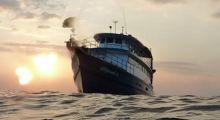 Liveaboard diving is scuba diving from a boat which you stay and sleep on for a couple of days up to more than a week. There are many different kinds of boat, from low-budget converted fishing vessels to purpose-built yachts and refurbished classic junks, and even catamaran cruisers.
Liveaboard diving is scuba diving from a boat which you stay and sleep on for a couple of days up to more than a week. There are many different kinds of boat, from low-budget converted fishing vessels to purpose-built yachts and refurbished classic junks, and even catamaran cruisers. 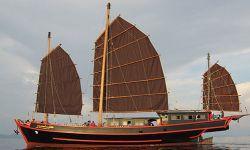 Forgetting about the high end of the luxury scale for a moment, let’s look at what an average day on a mid-range scuba diving liveaboard boat involves. It depends on when in the day the boat sets sail and how far away the diving sites are, but generally departure is in the evening with the first dive the following morning. Three and four day diving liveaboard trips usually follow the same pattern of activities, but vary the diving locations.
Forgetting about the high end of the luxury scale for a moment, let’s look at what an average day on a mid-range scuba diving liveaboard boat involves. It depends on when in the day the boat sets sail and how far away the diving sites are, but generally departure is in the evening with the first dive the following morning. Three and four day diving liveaboard trips usually follow the same pattern of activities, but vary the diving locations.
Although most people when on vacation want to lie in bed for as long as possible and enjoy the comfort of o soft bed and no agenda for the day ahead, those on diving liveaboard trips tend to have different ideas. Sometimes the bed and room (cabin) that is slept in is comfortable and difficult to get out of in the morning, but budget liveaboard boats don’t go too far in catering for luxury. The alarm call is usually at about 6.00-6.30am and passengers are advised to get up quickly and not bother with a shower or much breakfast. After a dive briefing about the likely sea conditions, topography under the surface and most interesting members of the marine life community likely to be encountered, it’s time to gear up and get in the water. Those reading this in temperate zones may feel a chill going through their spines at the thought of getting in the sea at 7.00am, but in places such as the Thailand, the temperature is very nice, and nothing to be worried about. It’s important for the first dive of any diving liveaboard trip to be quite easy, in order for the tour leader to check the levels of divers. However, for technical diving reasons, the first dive of the day also needs to the deepest.
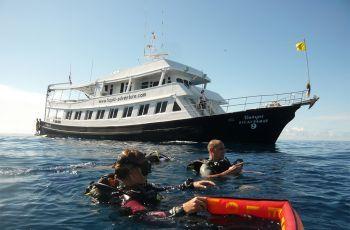 Depending on exactly what time the first dive took place and came to an end dictates what time the divers get in the water for the second dive. Generally a two hour surface interval involves proper breakfast, maybe a shower and lots of discussion about the day ahead. There are those who want to relax and sunbathe before the top deck becomes too hot, and others who maybe make adjustments to photographic or diving equipment. Reading books and generally chilling out is the main activity on any diving liveaboard trip. Typically, the second dive takes place late morning and is usually much the same as dive one, but slightly shallower.
Depending on exactly what time the first dive took place and came to an end dictates what time the divers get in the water for the second dive. Generally a two hour surface interval involves proper breakfast, maybe a shower and lots of discussion about the day ahead. There are those who want to relax and sunbathe before the top deck becomes too hot, and others who maybe make adjustments to photographic or diving equipment. Reading books and generally chilling out is the main activity on any diving liveaboard trip. Typically, the second dive takes place late morning and is usually much the same as dive one, but slightly shallower.
The next surface interval is a little longer, and this gives the passengers time to snorkel, have a sleep, write in logbooks, or just chill and chat with other divers in the group. Lunch is served and is usually buffet style, with a little local food but mainly safe international (western) cuisine. It’s never a good idea to get straight in the water after a heavy meal, so lunch is usually served after everyone has had chance to take a shower but not too near the start of dive three.
Dive three is usually at about two or three in the afternoon and is often a lot of fun. Some people will be tired, but others are just getting into the swing of things by mid afternoon. The dive should be shallower than in the morning, and therefore usually lasts longer, although most diving liveaboard operators limit the maximum time of any dive to one hour. Being in shallower water usually means more light and more life, and many divers are having great fun by the time they need to surface for the final daylight dive of the day.
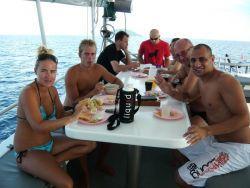 Many divers choose to just take part in three dives per day, although the trip price includes four. Night diving is fun and interesting, but not to everyone’s taste. It’s also worth bearing in mind that with cold beer on most diving liveaboard boats, it’s awfully difficult to stay away from in the mid and late afternoon. Drinking any alcohol almost always means that no more diving can be done that day, and there’s nothing wrong in that. Those who choose to relax, with or without alcohol, for the rest of the day and evening can do so, but they have to wait for dinner until those who go on the night dive have returned and showered. The surface interval between dive 3 & 4 often involves a trip to the beach on the nearest island and maybe some climbing, beach sports, a short trek or just playing in the sand,
Many divers choose to just take part in three dives per day, although the trip price includes four. Night diving is fun and interesting, but not to everyone’s taste. It’s also worth bearing in mind that with cold beer on most diving liveaboard boats, it’s awfully difficult to stay away from in the mid and late afternoon. Drinking any alcohol almost always means that no more diving can be done that day, and there’s nothing wrong in that. Those who choose to relax, with or without alcohol, for the rest of the day and evening can do so, but they have to wait for dinner until those who go on the night dive have returned and showered. The surface interval between dive 3 & 4 often involves a trip to the beach on the nearest island and maybe some climbing, beach sports, a short trek or just playing in the sand,
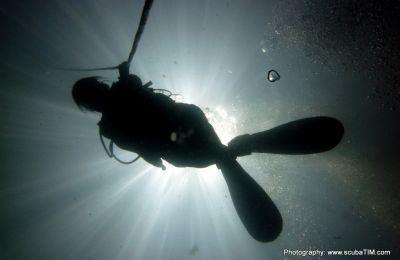 The fourth and final dive of the day is the night dive, which usually takes place at 6-6.30pm. For safety reasons, night dives are nearly always considerably shorter in time and shallower than the day dives which precede them. Typically, less than 20 metres maximum depth and thirty minutes is enough to satisfy those who have been in the water for most of the day. Night diving may sound daft, but there is always lots to see. Sleeping fish, especially Parrotfish which surround themselves in a membrane so that predators can’t detect the electrical field which all animals emit, are fun to spot. The most commonly-seen creatures on night dives are crustaceans, such as crabs and shrimps. Octopuses are more active at night, as are their cousins, squid. Moray Eels aren’t the best swimmers, so they hide in holes during the day and swim across the reef at night, hunting for whatever they can find. Probably the most exciting fish to see on night dives are hunting sharks, such as Whitetip Reef Sharks. These ravenous predators hunt in packs over the reef and anything they find is soon gobbled up.
The fourth and final dive of the day is the night dive, which usually takes place at 6-6.30pm. For safety reasons, night dives are nearly always considerably shorter in time and shallower than the day dives which precede them. Typically, less than 20 metres maximum depth and thirty minutes is enough to satisfy those who have been in the water for most of the day. Night diving may sound daft, but there is always lots to see. Sleeping fish, especially Parrotfish which surround themselves in a membrane so that predators can’t detect the electrical field which all animals emit, are fun to spot. The most commonly-seen creatures on night dives are crustaceans, such as crabs and shrimps. Octopuses are more active at night, as are their cousins, squid. Moray Eels aren’t the best swimmers, so they hide in holes during the day and swim across the reef at night, hunting for whatever they can find. Probably the most exciting fish to see on night dives are hunting sharks, such as Whitetip Reef Sharks. These ravenous predators hunt in packs over the reef and anything they find is soon gobbled up.
So, after four dives in one day, dinner can be served and enjoyed. It’s a little sad that there is often some kind of seafood on the menu, but such is life. This is an ideal time to enjoy a beer or glass of wine and sit back to tell stories and jokes or just gaze at the stars. Liveaboard diving really is a wonderful experience and something that should be enjoyed by all certified scuba divers. It’s not too expensive, especially considering food and accommodation are included, and usually offers much better diving than what is available from diving one or two dives from the mainland and returning each day.


